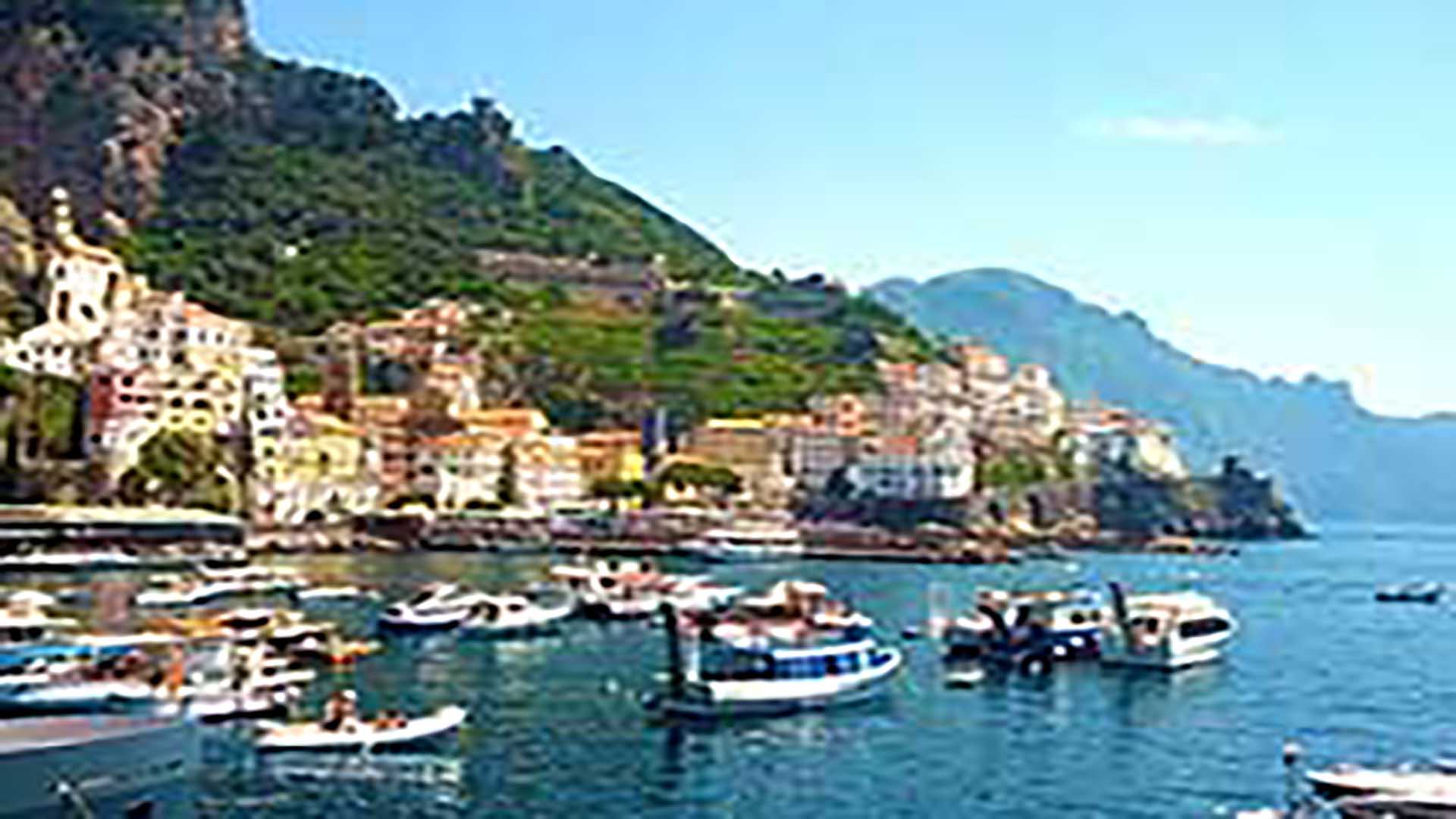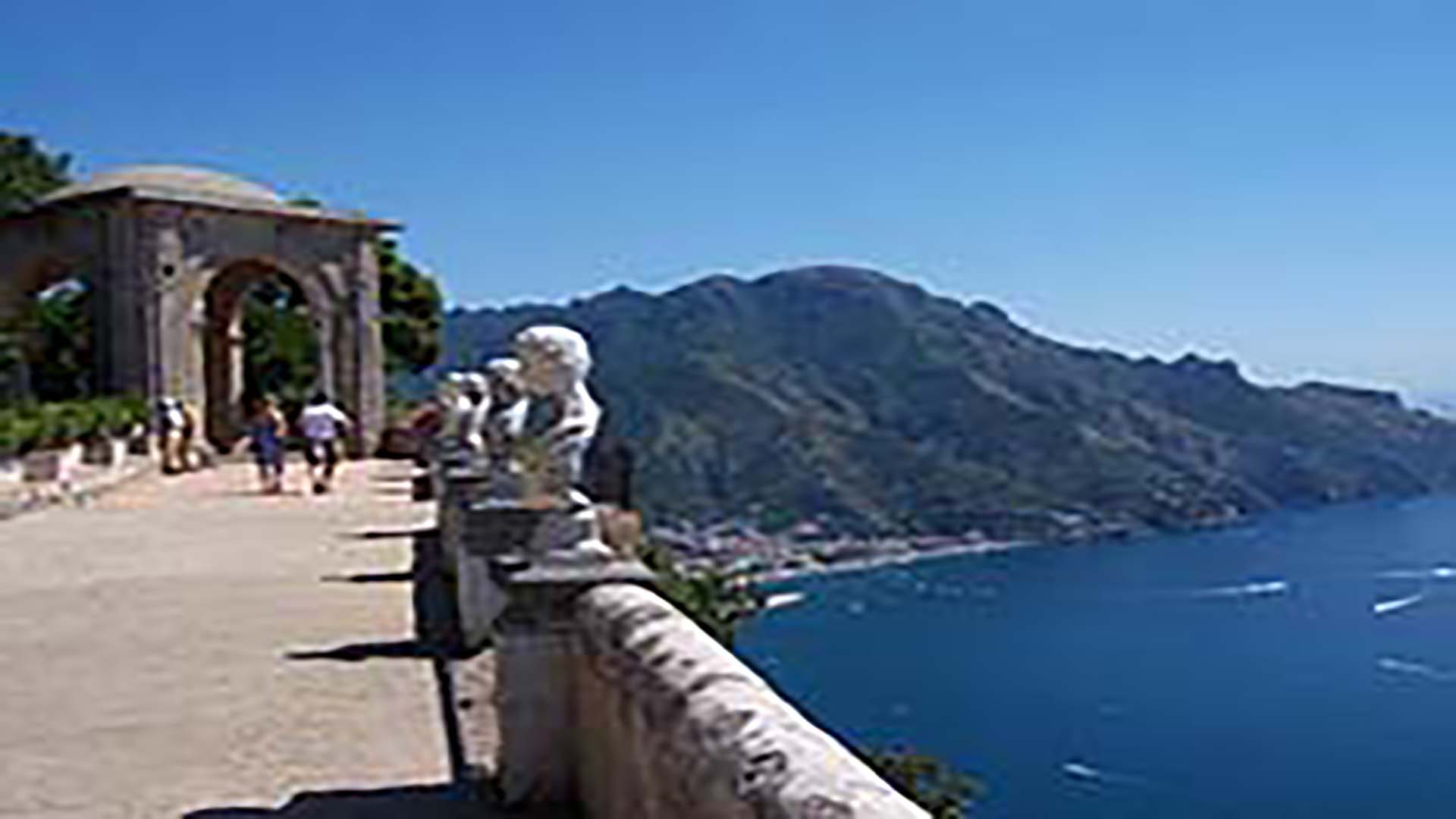Amalfi is first mentioned in the 6th century, and soon acquired importance as a maritime power, trading its grain, salt and slaves from the interior, and even timber, for the gold dinars minted in Egypt and Syria, in order to buy the silks of the Byzantine empire that it resold in the West. Merchants of Amalfi were using gold coins to purchase land in the 9th century, while most of Italy worked in a barter economy. In the 8th and 9th century, when Mediterranean trade revived it shared with Gaeta the Italian trade with the East, while Venice was in its infancy, and in 848 its fleet went to the assistance of Pope Leo IV against the Saracens.
An independent republic from the seventh century until 1075, it rivalled Pisa and Genoa in its domestic prosperity and maritime importance. It was then an independent republic with a population of some 70,000, reaching an apogee about the turn of the millennium, during the reign of Duke Manso(9661004). Under his line of dukes, Amalfi remained
independent, except for a brief period of Salernitan dependency under Guaimar IV.
In 1073 it fell to the Norman countship of Apulia, but was granted many rights. A prey to the Normans who encamped in the south of Italy, it became one of their principal posts. However, in 1131, it was reduced by King Roger II of Sicily, who had been refused the keys to its citadel. The Holy Roman Emperor Lothair, fighting in favour of Pope Innocent II against King Roger of Sicily, who sided with theAntipope Anacletus, took him prisoner in 1133, assisted by forty-six Pisan ships. The city was sacked and Lothair claimed as part of the booty a copy of the Pandects of Justinian which was found there.
Amalfi was a populous city between the thirteenth and fourteenth centuries. In 1135 and1137, it was taken by the Pisans and rapidly declined in importance, though its maritime code, known as the Tavole Amalfitane, was recognized in the Mediterranean until 1570.
In medieval culture Amalfi was famous for its flourishing schools of law and mathematics.Flavio Gioia, who is traditionally considered the first to intrudece mariner’s compass to Europe, is said to be a native of Amalfi.
In 1343 a large part of the lower town was destroyed by a tsunami, and its harbor is now of little importance.
Amalfi occupied a high position in medieval architecture; its cathedral of Sant’ Andrea, of the eleventh century, the campanile, the convent of the Capuccini, founded by Cardinal Capuanor, richly represent the artistic movement prevailing in Southern Italy at the time of the Normans, with its tendency to blend the Byzantine style with the forms and sharp lines of the northern architecture.
Burial place of Saint Andrew
The Catholic Encyclopedia notes that Saint Andrew‘s relics were brought from Constantinople to Amalfi in Campania, by the Amalfitan Pietro, cardinal of Capua, in 1210 after the completion of the town’s cathedral. The cathedral, dedicated to St Andrew (as is the town itself), contains a tomb in its crypt that it maintains still holds a portion of the remains of the body of the apostle. You can also see a golden requiary which originally housed his skull and another one used to parade the bones around Amalfi on holy days.
Amalfi is the main town of the coast on which it is located, named Costiera Amalfitana, and is today an important tourist destination together with other towns on the same coast, such asPositano, Ravello and others. Amalfi is included in the UNESCO World Heritage Sites.
The Amalfi coast is famed for its production of Limoncello liqueur and home-made paper used throughout Italy for wedding invitations.
According to the tradition, Hercules, strength pagan god, loved a nymph called Amalfi, but his love was short: she died and Hercules buried her in the most beautiful place of the world, and to immortalize her, he gave it her name. According to the history, it was founded after Constantino’s death; its origins came from Roman families.
The first news are about 533, during the Greek-Gothic war, with the victory of Narsete against Teia, Amalfi is under the rule of Byzantine Empire and it starts to be a part of Naples dukedom. In the VI century it’s a diocese. The bishop absolved religious services and he provided to town’s defence. Some aristocratic, landowners, deprived the bishop of his politic power. In 836 Sicardo, duke of Benevento, raided Amalfi Coast, deporting the inhabitants to Salerno. In 839, Sicardo was killed, the Amalfitans rose, conquering a power and an autonomy that remained until the end of the XI century. Amalfi became Republic in 850. Very often Amalfi united itself with Saracens and Ludovico II against Byzantines, that wanted to restore the
sovereignty of the Eastern Empire.
Anyway, the alliance with Saracens was unstable and not lasting. In 915, after a very cruel battle, Saracens were defeated and definitely sent away of Reggio Calabria. For all the X century and the beginning of the XI century, the Amalfitans had a commercial increase and a very reliable economic welfare, taking a very important seat in the Mediterranean, the same seat that Pisa and Genova had later. The richness of Amalfi was so big that Guglielmo Appulo wrote that only this town was so rich of gold, silver and every kind of fabrics and it was visited by Arabians, Sicilians, Africans and Indians.
That’s because they had by Amalfitans the most ancient codifications, in the famous “Tabula Amalphitana”, that was the most accredited code of all the sailor nations of that time. It controlled the relations between ship’s master and sailor, between sailors and traders. The same Flavio Gioia’s legend, probably lived at the beginning of the XIV century, gives to Amalfi the credit to have perfected the compass for the navigation and given materials about the first medieval nautical papers. Ruler in spices field, in scents, in silk and precious carpets, in the X century Amalfi coined the Golden Coin, the golden and silver Tar?, that were used in Greek Empire, in Afric and in Longobardo principate.
Amalfi’s development was so high thanks to its independence. In 1039 Guaimario V, prince of Salerno, took possession of amalfi’s dukedom, with the dominion of Salerno on Amalfi. Pressed by salerno, the amalfitans governed by Sergio IV, asked to Roberto il Guiscardo, in 1073, to help them. Salerno capitulated but amalfitans were conquered by Normans. After the Norman king’s death, in 1085, Amalfi tried to be free out of Normans power. In 1135 Amalfi suffered a horrible sack by Pisani, traitors, called for helping against Normans. It’s from now that Amalfi’s decadence began. In 1343 a terrible sea-quake, described by Petrarca, hit the coast, the most part of the town was destroyed (probably with it also the Ducal Palace, mentioned in a document as Palatium Amalphitanum), the fortifications were submerged, the shipyards, nautical equipments.
Five years later, the famous plague of 1348, described by Boccaccio, completed the destruction among people. Amalfi and all coast towns, that were beautiful places, populated and fortified, rich of beautiful places, decorated by frescoes, marbles, columns, fountains, became modest towns, without richness, coming back to the traditional economy: fishing, local handicrafts, agriculture. Only at the end of nineteenth century, tourism gave to amalfi a very big increase, that now is the economic epicentre of all the coast that from Amalfi takes its name.
The coastline just south of Naples, known as the AMALFI COAST, is undoubtedly one of the most beautiful in the world. It as an inherent natural beauty characterised by very steep, rocky hillsides falling sheer into the sea, and the local villages, untouched by modern architecture, which used to be dedicated to fishing, have retained all their centuries-old charm. Sightseers, if they really want to absent themselves from this beautiful area, can visit Naples, Pompei and Vesuvius. Ravello, just above Amalfi, has two enchanted villa gardens with views of the coastline. Capri and Ischia are islands nearby, both of extraordinary natural beauty.
For affordable food and accommodation, you’d do better to push on to Amalfi, the largest town along this coast and an established seaside resort since Edwardian times, when the British upper classes spent their winters here. An independent republic in Byzantine times, Amalfi was one of the great naval powers with a population of some seventy thousand. Vanquished by the Normans in 1131, it was devastated by an earthquake in 1343. A few remnants of Amalfi’s past glories survive, and the town has a crumbly attractiveness that makes it fun to wander through.
The Amalfi Coast
The Duomo, at the top of a steep flight of steps, dominates the town’s main piazza, its decorated, almost gaudy facade topped by a glazed tiled cupola that’s typical of the region. Inside, it’s a mixture of Saracen and Romanesque styles, though now heavily restored, with a major relic in the body of St Andrew buried in its crypt. The most appealing part of the building is the cloister oddly Arabic in feel, with its whitewashed arches and palms. Close by, the Museo Civico displays the original Tavoliere Amalfitane the book of maritime laws which governed the republic, and the rest of the Mediterranean, until 1570. Beyond these, the focus is along the busy seafront, where there’s an acceptably crowded beach.
You can visit the Cathedral which was built in the eleventh century, rebuilt in the Arab-Norman style in the twelfth and further altered in the eighteenth. The bell tower was built between the twelfth and thirteenth centuries. The thirteenth century Paradise cloisters, surrounded by an elegant portico with pointed, interwoven arches and supporting columns, was built by Archbishop Filippo Augustariccio as a sepulchre for illustrious people of the town. You can also visit the arsenal of the Republic which is a grandiose Gothic construction, the Cappuccini Hotel which was a thirteenth century convent with cloisters and a loggia, the Civic Museum containing the Tabula Amalphitana which is the oldest navigational manual in the world, and the map museum.
The early beginnings of Amalfi are very obscure; it is not known when it was founded, or when Christianity reached it. That it was early is a reasonable conjecture, considering the facilities for communication with the East which the South of Italy possessed.
The first positive indication that Amalfi was a Christian community is supplied by popeGregory the Great, who wrote in January 596 to the Subdeacon Antemius, his legate and administrator in Campania, ordering him to constrain within a monastery Primenus, Bishop of Amalfi, because he did not remain in his diocese, but roamed about (Reg., V, xiv; cf. Jaff, RR.PP., 1403). The regular list of bishops began in 829.
It was raised to an archbishopric by pope John XV in 987. In 1206, after the completion of thecathedral ofSt. Andrew, the body of the Apostle of that name, patron saint of Amalfi, was brought there fromConstantinople by Pietro, cardinal of Capua, an Amalfitan.
The archbishopric had in the early 20th century about 36,000 inhabitants, 54 parishes and 279 secular priests.
THE HISTORICAL BOAT-RACE
The famous period boat-race between tbc four Italian sca Republics, that takes place every year in one of them in rotation, is a very recent innovation. As a matter of fact, Mirro Chiaverini from Pisa decided to set up this boat-race after tbc Second World War. However, in order to do so, it was necessari to overcome the resistance of Venice, that did not accept the idea, perhaps considerino its history more important than that of tbc others.
Curiously, it is in fact Venice that boasts the highest number of victories, while Amalfi won in ’95, ’96, ’97. This very charming manifestation also provides for a fashion parade of period costumes and ends with spectacular fireworks which are particularly beautiful in Amalfi Coast, where they boast a great tradition.
Amalfi

costiera amalfitana itinerario
Amalfi
ultima modifica: 2016-08-21T17:58:24+02:00
da

